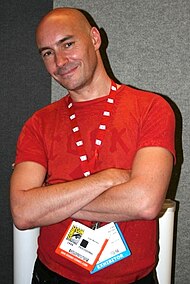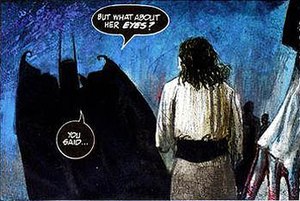
The Joker is a supervillain appearing in American comic books published by DC Comics. The character was created by Bill Finger, Bob Kane, and Jerry Robinson, and first appeared in the debut issue of the comic book Batman on April 25, 1940. Credit for the Joker's creation is disputed; Kane and Robinson claimed responsibility for the Joker's design while acknowledging Finger's writing contribution. Although the Joker was planned to be killed off during his initial appearance, he was spared by editorial intervention, allowing the character to endure as the archenemy of the superhero Batman.

The Elizabeth Arkham Asylum for the Criminally Insane, commonly referred to as Arkham Asylum, is a fictional psychiatric hospital/prison, named after the city of Arkham which appeared first in the stories of H. P. Lovecraft, and later appearing in American comic books published by DC Comics, commonly in stories featuring the superhero Batman. It first appeared in Batman #258, written by Dennis O'Neil with art by Irv Novick. The asylum serves as a (forensic) psychiatric hospital for the Gotham City area, housing patients who are criminally insane, as well as select prisoners with unusual medical requirements that are beyond a conventional prison's ability to accommodate. Its high-profile patients are often members of Batman's rogues gallery.
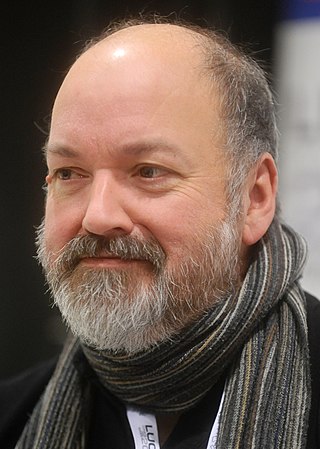
David McKean is an English artist. His work incorporates drawing, painting, photography, collage, found objects, digital art, and sculpture. McKean has illustrated work by authors such as Neil Gaiman, Grant Morrison, Heston Blumenthal, Ray Bradbury and Stephen King. He has also directed three feature films.

Grant Morrison MBE is a Scottish comic book writer, screenwriter, and producer. Their work is known for its nonlinear narratives, humanist philosophy and countercultural leanings. Morrison has written extensively for the American comic book publisher DC Comics, penning lengthy runs on Animal Man, Doom Patrol, JLA, Action Comics, and The Green Lantern as well as the graphic novels Arkham Asylum, JLA: Earth 2, and Wonder Woman: Earth One, the meta-series Seven Soldiers and The Multiversity, the mini-series DC One Million and Final Crisis, both of which served as centrepieces for the eponymous company-wide crossover storylines, and the maxi-series All-Star Superman. Morrison's best known DC work is the seven-year Batman storyline which started in the Batman ongoing series and continued through Final Crisis, Batman and Robin, Batman: The Return of Bruce Wayne and two volumes of Batman Incorporated. They also co-created the DC character Damian Wayne.
Sam Kieth is an American comics artist and writer, best known as the creator of The Maxx and Zero Girl.

Batman: The Killing Joke is a 1988 DC Comics one-shot graphic novel featuring the characters Batman and the Joker written by Alan Moore and illustrated by Brian Bolland. The Killing Joke provides an origin story for the supervillain the Joker, loosely adapted from the 1951 story "The Man Behind the Red Hood!", which was written by Batman co-creator Bill Finger. The Joker's origin is presented via flashback, while simultaneously depicting his attempt to drive Jim Gordon insane and Batman's desperate attempt to stop him.

Doctor Destiny is a supervillain appearing in American comic books published by DC Comics.

Paul McClaran Dini is an American screenwriter and comic creator. He has been a producer and writer for several Warner Bros. Animation/DC Comics animated series, most notably Batman: The Animated Series (1992–1995), and the subsequent DC Animated Universe. Dini and Bruce Timm co-created the characters Harley Quinn and Terry McGinnis.
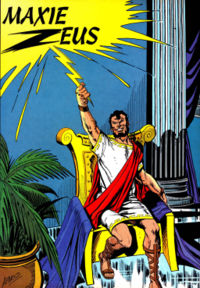
Maximilian "Maxie" Zeus is a supervillain appearing in American comic books published by DC Comics, primarily as a minor enemy of Batman. He is depicted as a mentally ill former history professor who is obsessed with Greek mythology and believes himself to be the god Zeus, becoming a crime lord in Gotham City.

The Batman Adventures: Mad Love is a one-shot comic book written by Paul Dini and Bruce Timm. It won the Eisner Award for Best Single Issue and the Harvey Award for Best Single Issue or Story in 1994. It was later adapted as an episode of the animated series The New Batman Adventures, and incorporated in the video games Batman: Arkham Asylum and Batman: Arkham Origins. In 2018, Titan Books released a novelization of Mad Love written by Dini and Pat Cadigan, which expanded upon the original comic book.
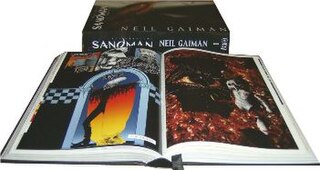
DC Comics Absolute Edition is a series of archival quality printings of graphic novels published by DC Comics and its imprints WildStorm Productions and Vertigo. Each is presented in a hardcover and slipcased edition with cloth bookmark consisting of one or more books which include restored, corrected and recolored versions of the original work, reprinted at 8 by 12 inches. Also included are supplemental materials regarding the creation of the work, including sketches, comic scripts and memos.

"Batman and Son" is a 2006 comic book story arc featuring the DC Comics character Batman. Written by Grant Morrison and drawn by Andy Kubert, the story was published in four parts in the comic book Batman starting in #655 and ending in #658. The story was the beginning of Morrison's run in the Batman comic as well as their long-term take on the character of Batman through multiple titles over the next seven years. The arc introduced Batman's son, Damian Wayne, bringing him into the mainstream continuity of the DC Universe.

"The Last Arkham" was a four-part Batman story arc that started the Batman: Shadow of the Bat comic book series in mid-1992. The storyline began in Batman: Shadow of the Bat #1, and finished in Batman: Shadow of the Bat #4. DC Comics later compiled the four issues into a trade paperback in 1995. The comic was written by Alan Grant and drawn by Norm Breyfogle and was responsible for the introduction of several new characters into the Batman universe.
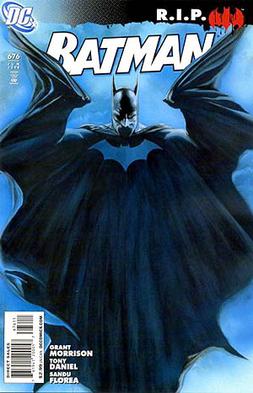
Batman R.I.P. is an American comic book story arc published in Batman #676–681 by DC Comics. Written by Grant Morrison, penciled by Tony Daniel, and with covers by Alex Ross, the story pits the superhero Batman against the Black Glove organization as they attempt to destroy everything that he stands for. It has a number of tie-ins in other DC Comics titles describing events not told in the main story.

Batman: Arkham Asylum is a 2009 action-adventure game developed by Rocksteady Studios and published by Eidos Interactive in conjunction with Warner Bros. Interactive Entertainment. Based on the DC Comics superhero Batman and written by veteran Batman writer Paul Dini, Arkham Asylum was inspired by the long-running comic book mythos. In the game's main storyline, Batman battles his archenemy, the Joker, who instigates an elaborate plot to seize control of Arkham Asylum, trap Batman inside with many of his incarcerated foes, and threaten Gotham City with hidden bombs.

This is a bibliography of the Scottish comic book writer Grant Morrison.
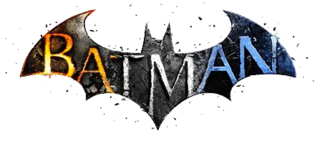
Batman: Arkham is a series of action-adventure video games based on the DC Comics character Batman, developed by Rocksteady Studios and WB Games Montréal, and published originally by Eidos Interactive and currently by Warner Bros. Games. The franchise consists of four main installments and an upcoming spin-off, along with four smaller titles for mobile devices, a virtual reality game, tie-in comic books, and an animated film. The continuity established by the games is often referred to as the Arkhamverse.
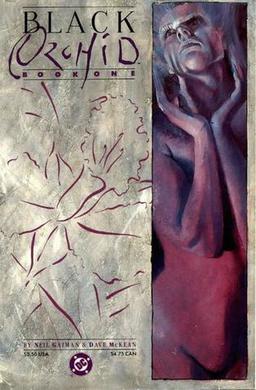
Black Orchid is an American comic book written by Neil Gaiman with art by Dave McKean. It was published by DC Comics as a three-issue limited series from December 1988 to February 1989, and was later reprinted in trade paperback form. Black Orchid follows two girls, Flora and Suzy, who awaken in a greenhouse. Their journey to find out who they are leads them into contact with DC Universe figures like Batman and Swamp Thing, but also into conflict with criminal mastermind Lex Luthor, who seeks them for his own interests.
Jeremiah Arkham is a fictional supervillain and the head of the Arkham Asylum in DC Comics, created by Alan Grant. Arkham was created in 1992, and slowly "lost his mind" during his time in the Arkham Asylum, subsequently becoming the second Black Mask. Though described as a sadist, Arkham seems to believe his intentions are for the benefit of his patients.

